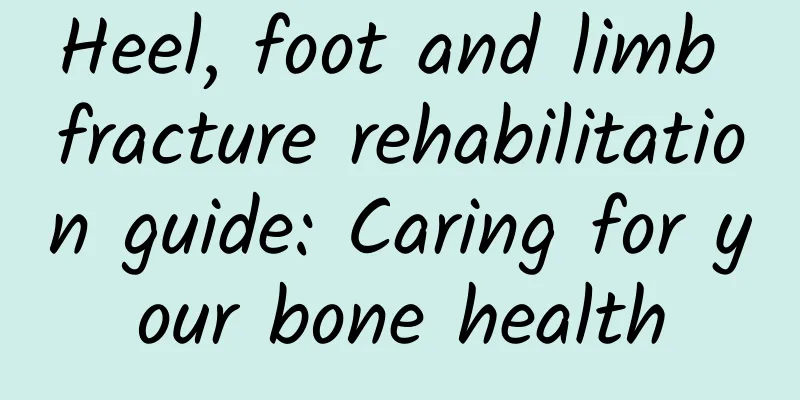Heel, foot and limb fracture rehabilitation guide: Caring for your bone health

|
In our daily lives, we may suffer fractures due to various reasons, such as accidental falls, sports injuries, etc. Fractures are a common traumatic injury, especially fractures of the hands, heels, feet and limbs, which have a great impact on our lives and work. Therefore, it is particularly important to understand the rehabilitation knowledge of fractures and care about our bone health. 1. Definition and classification of fractures Fracture refers to a pathological change in which the continuity of bones is destroyed under the action of external forces. According to the location, shape and degree of fracture, fractures can be divided into the following categories: Classification by location: It can be divided into upper limb fractures (such as humerus, ulna, radius, etc.), lower limb fractures (such as femur, tibia, fibula, etc.) and trunk fractures (such as thoracic vertebrae, lumbar vertebrae, etc.). Classification by morphology: It can be divided into transverse fracture, oblique fracture, spiral fracture, comminuted fracture, etc. Classification by degree: It can be divided into complete fracture (complete break of the bone cortex), incomplete fracture (partial break of the bone cortex) and stable fracture (the fracture ends are stable and not easy to displace), etc. 2. Diagnosis and treatment of fractures Diagnosis: The diagnosis of fracture mainly relies on medical history, physical examination and imaging examination. Medical history mainly includes the injury process, pain site, activity limitation, etc.; physical examination mainly includes observation of local skin, muscles, joints, etc., as well as palpation and percussion, etc.; imaging examination mainly includes X-ray, CT, MRI, etc. Treatment: The treatment principles of fractures are reduction, fixation and functional exercise. Reduction refers to restoring the fracture ends to their normal anatomical position; fixation refers to fixing the fracture ends in a certain position using plaster, splints, brackets, etc. to facilitate healing; functional exercise refers to appropriate rehabilitation training after fracture healing to restore joint mobility and muscle strength. III. Rehabilitation of fractures of hands, heels, feet and limbs Rehabilitation goal: The rehabilitation goal of heel, foot and limb fractures is to restore joint range of motion, muscle strength and daily living ability, and reduce the occurrence of complications. Rehabilitation stage: Rehabilitation of heel, foot and limb fractures is divided into early rehabilitation (1-2 weeks after injury), mid-term rehabilitation (2-6 weeks after injury) and late rehabilitation (after 6 weeks after injury). Early rehabilitation: The main tasks of early rehabilitation are to relieve pain, reduce swelling and stop bleeding, prevent infection and promote blood circulation. Specific measures include: raising the affected limb, cold compress, local massage, drug treatment, etc. In addition, some passive joint movement and muscle contraction training can be performed to prevent joint stiffness and muscle atrophy. Mid-term rehabilitation: The main task of mid-term rehabilitation is to restore joint mobility and muscle strength. Specific measures include: active joint activity training, muscle strength training, balance training, etc. In addition, some functional training can also be performed, such as going up and down stairs, walking, etc., to improve daily living ability. Late rehabilitation: The main task of late rehabilitation is to consolidate the results of early rehabilitation and improve joint stability and muscle endurance. Specific measures include: continuous joint activity training, muscle strength training, balance training, etc. In addition, some aerobic exercise and resistance training can also be performed to improve cardiopulmonary function and muscle endurance. 4. Precautions for fracture rehabilitation Follow your doctor’s advice: When rehabilitating a fracture, it is important to follow your doctor’s advice and instructions to avoid worsening the injury or causing other complications. Gradual progress: Rehabilitation training should proceed from simple to complex, from low intensity to high intensity, and gradually increase the amount and difficulty of training to avoid excessive fatigue or injury. Pay attention to safety: During rehabilitation training, pay attention to the safety of the environment to avoid accidents such as falls or collisions. If necessary, use walking aids or help from others. Diet adjustment: A reasonable diet is helpful for fracture healing and recovery. You should ensure adequate intake of nutrients such as protein, calcium, phosphorus, etc. At the same time, pay attention to controlling calorie intake and avoid obesity. Psychological adjustment: Fracture patients may experience psychological problems such as anxiety and depression. They should actively adjust their mentality and maintain an optimistic and positive attitude to facilitate recovery. In short, the rehabilitation of hand, heel, foot and limb fractures is a long and complicated process that requires the joint efforts of patients and their families. Through scientific rehabilitation methods and reasonable life adjustments, we can restore bone health as soon as possible and return to a better life. V. Conclusion Heel, foot and limb fractures are a common traumatic injury that has a great impact on our lives and work. It is particularly important to understand the knowledge of fracture rehabilitation and care for our bone health. Through scientific rehabilitation methods and reasonable life adjustments, we can restore bone health as soon as possible and return to a better life. I hope this article can provide you with useful information about the rehabilitation of heel, foot and limb fractures, and help you better care for your bone health. |
>>: High-risk factors for colorectal cancer and population screening guidelines
Recommend
How many days does it normally take for your first menstrual period
A girl's first period usually lasts 3 to 5 da...
What is foamy leucorrhea?
Normal leucorrhea not only has no peculiar smell ...
Bleeding after having sex after the period ends
Bleeding after menstruation is mostly caused by c...
Ovarian structure diagram
The uterus and ovaries are the reproductive organ...
What happens when you are pregnant?
Full-term pregnancy is 40 weeks, in other words, ...
How to take care of women after menopause
When women enter menopause, their mood changes ar...
I got pregnant even though I had my period normally.
Normally, women do not have their periods when th...
What to do if female genitals itch
Some female patients have vulvar itching, which s...
What are the symptoms of hormone imbalance in women?
There are many hormones in the human body. The ho...
Does ovulation only occur on one day?
The ovulation period is a period of easy concepti...
Befriend butterflies and be reborn
Author: Wang Xiuli Shengjing Hospital Affiliated ...
Can the endometrium regenerate?
The endometrium is not a static tissue. If the en...
I took birth control pills once during breastfeeding
Nowadays, many couples hope to have more space fo...
A high school student was sleepy, and a checkup revealed that he was suffering from severe depression! Which key groups are more likely to have psychological problems?
Recently, it was reported that a high school soph...









